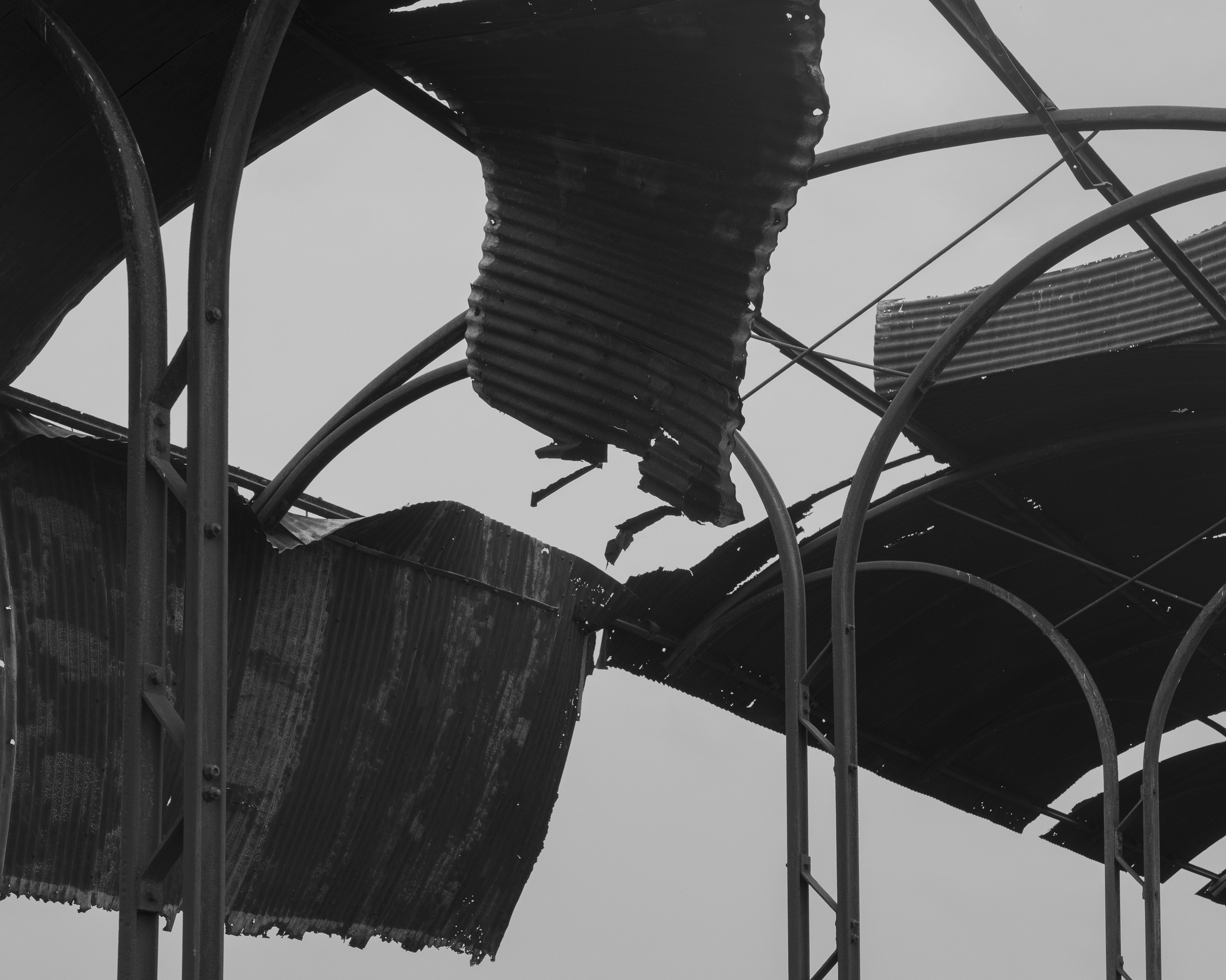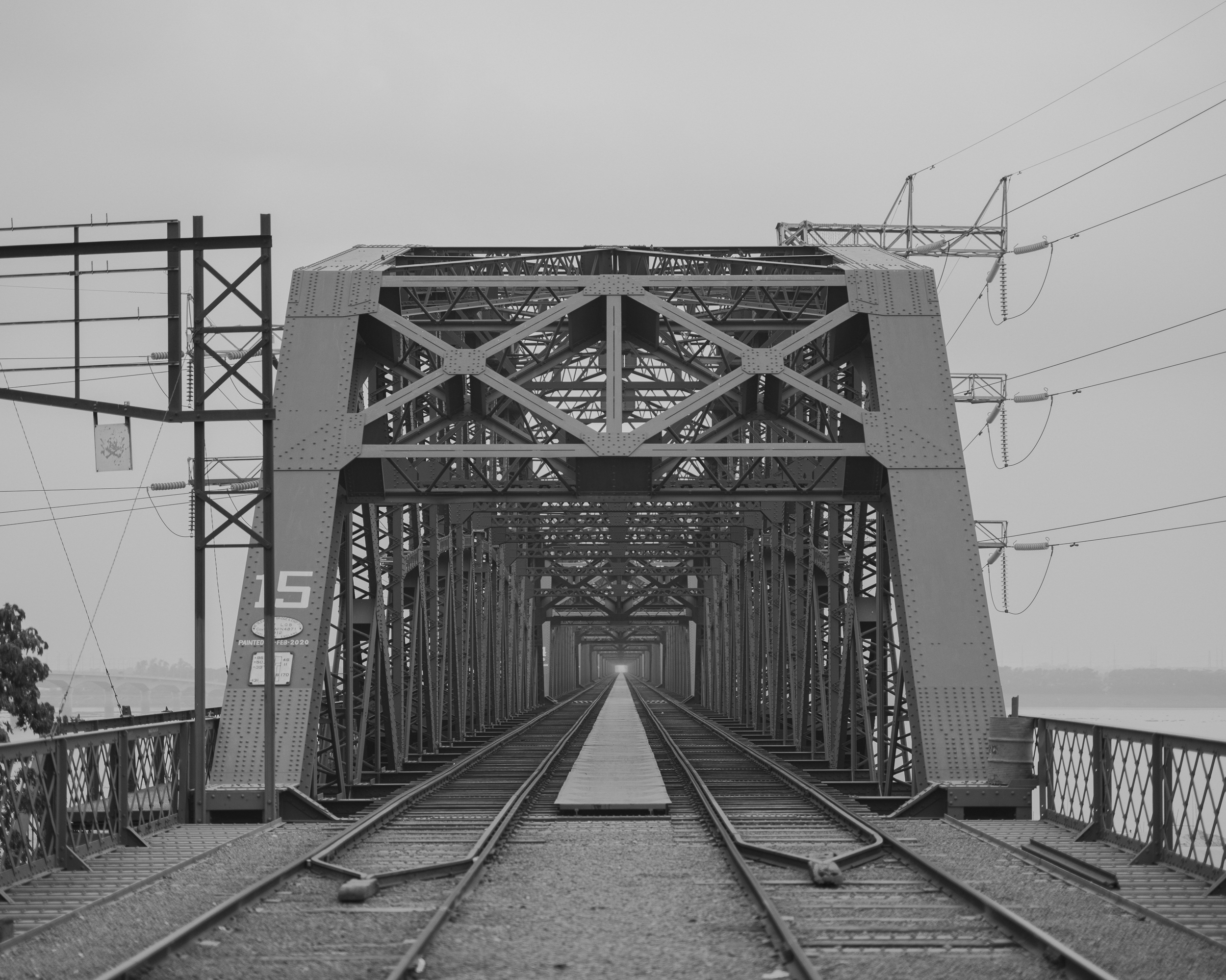CROSSING
Bengal Connected
PHOTOGRAPHS BY SARKER PROTICK. TEXT BY NAEEM MOHAIEMEN.







In Satyajit Ray's 1955 neo-realist classic Pather Panchali (Song of the Little Road), the details of village life in turn of the century Bengal float on a breeze of gentle games, rituals, and boredom of two young children. In an early scene, at once promise and danger, the children chase each other through a dense kash grass field and then suddenly stop, games forgotten. These inhabitants of a remote village in British India have stumbled upon an alien creature of iron and smoke. A train cuts the horizon line and bifurcates the cinema screen at an angle. The modernity of mechanized transport has arrived somewhere at a distance; though it may bring opportunity, it also hints at how quiet village lives, with no sense of an outside world, are about to change forever. Ray placed the railway as a jagged arrival in the lives of naive, happy village humans. All that befell their lives in subsequent years–mysterious disease, loss of prestige, eroding religious rites, forced migration, and city alienation–unfold over three harrowing films that make up the Apu Trilogy.
In Sarker Protick's long-term research project, the camera gaze has shifted from that far-away child's view, to a chastened adult nation's silent witnessing. His canvas is the sinewy rail system that is the British Empire's lasting mark on the part of India that was once East Bengal, then East Pakistan, and finally Bangladesh. Reversing Ray, these photographs have emptied the space of people–what we see instead are skeletal train tracks, and the architecture of commerce, habitation, manufacturing, and entertainment that grew up around this ecosystem of connectivity. There are occasional human figures–a nurse, an entertainer, a sanyasi–but they carry an air of confusion, almost as if the mela of human activity that surrounded these depots for a century have abandoned them, and they forgot to catch the last train leaving the station.
















On the 75th anniversary of the expulsion of Britain from its' "Jewel in the Crown" India, what consumes the memory-keepers is the brutal partition of India and Pakistan (and later Bangladesh: last act of 1947 played out in 1971). These narratives circumnavigate the horrors of communal riots and neighbor-on-neighbor betrayal at the midnight hour, and the tumultuous new lives that had to be built by displaced refugees. The provinces of Punjab and Bengal received the largest blows of bifurcation, losing half their landmass and population to a new "enemy" nation. Thus, they dominate the popular imagination, in works such as Toba Tek Singh (Saadat Hassan Manto, 1955) and Purba Pashchim (Sunil Gangopadhyay, 2000). Bangladesh has a complex position within these narratives, as it is marked by a condition of being left behind. While the Punjab province, after division, had a comparable level of population exchange and deaths, Bengal's splintering was accompanied by a massive exodus of Bengali Hindus from East Bengal into West Bengal in India, but not a similar Muslim in-flow into East Bengal. Today's Bangladesh usually appears within 1947 Partition stories as the bucolic "before" that had to be lost and abandoned.
The idea of being left behind in 1947 is a portal through which I enter the lifeblood of what was once East Bengal Railway and today is Bangladesh Railway. The visual specter and memory of families uprooted overnight, villages broken apart, and property lost or transferred during the destructive spiral of 1947 is legible to Partition scholars. What is less familiar is the ways in which the topography of connectivity and commerce was also split apart in ways that could never be repaired, and which left the new constituent parts denuded and impoverished. Among the lasting marks of infrastructure set in place by the British empire, the railway network was the most widespread and consequential.
Benedict Anderson's Imagined Communities (1983) established that mapmaking was an obsession of Empire so as to tabulate their total dominion, and to enumerate the potential for commerce and the necessity of control. Two facts, one topographic the other demographic, were put into bas relief by these cartographic expeditions. The first was the clarity that while East Bengal was the fertile, lush agricultural heartland, its connectivity to the administrative capital of Kolkata, and to the rest of British India, was sharply hampered by the densely riverine landscape, underscoring the phrase "nodimatrik" (whose mother is rivers). The second was the discovery of a massive Muslim demographic in East Bengal, changing the demand for a separate Muslim homeland of Pakistan in western India into an expanded call for "two wings" of Pakistan on either side of India. The first cartographic fact would lead to the creation of the East Bengal Railway system that successfully connected all of the Bengal province. The second would lead to the 1947 partition of Bengal, severing this same railway system from logical end points in West Bengal, Darjeeling, and Assam, rendering it a system in search of destination.


The first railway system in the world was set up in 1825; within 40 years the British had set up a private company called Eastern Bengal Railway to begin the eastward corralling, by rail lines, of their Indian empire. Dinak Sohani Kabir's East Bengal's Railway History, 1862-1947 (2007), delineates five railway tendrils in East Bengal: Eastern Bengal, Northern Bengal, Bengal Central, Dhaka-Mymensingh, and Assam Bengal. Partition split apart geographies such that the end points of most of these railway networks were in towns that overnight became "enemy territory" inside India. Eastern Bengal connected the capitals of the two Bengals: Dhaka and Kolkata, Northern Bengal connected Parbatipur and Darjeeling, Bengal Central linked Kolkata to Khulna, and Assam Bengal linked the southern tip of Bengal to Assam in the north. Within a plethora of lines, crossings, and junctions, what is salient is that the final destination for many railway lines became part of India after 1947. While trains continued for two more decades and were a site of refugee flows into India, the lines of control hardened and were partially severed after the 1965 India-Pakistan war.




British Railroad expansion was naturally linked to control and surveillance. The Sepoy Mutiny of 1857 frightened the British empire with its velocity and near-success. Rapid access, via the railway, to the far-flung regions of the empire was now deemed essential to suppress anti-British rebellions. There was unexpected anticolonial blowback to these control-and-develop concepts, seeding the destruction of the colonial project within railway success. While this new railway system led to hyper-development of Empire capitalism, it created a level of connectivity, a rising middle class and business community, and a newly empowered polity that allowed the flourishing of all-India political alliances. Moving beyond the provincial myopia and rivalry that assisted British divide-and-rule strategies, these pan-India movements became the national forces behind the "Quit India" movement that finally expelled the Second World War-exhausted British Crown by 1947. Railroads led to a zenith of colonial expansion, and also laid the tracks for its eventual annihilation.


Colonial capitalism focused on export goods that would reach the British metropole and its trading partners, especially tea (from vast British-controlled tea estates) and jute (the "golden fiber" whose revenue sharing later became a politically decisive point of friction between the two wings of Pakistan). The railway system led to explosive growth in overall trade; Kabir enumerates that the primary revenue goods of jute and tea were supplemented by indigo, ganja, sugar, tobacco, coal, cotton, silk, kerosene, rice, wheat, salt, and lentil. While the colonial apparatus siphoned off the vast majority of trade profits to the metropole and company coffers, the flow of revenue, work, and connectivity dramatically improved the financial and political position of the colonial subject, large and small, all along the rail paths. The employment industry that sprang up around the maintenance and management of railways created the phenotype of "railway man"—a more secure, upwardly mobile figure. That this new economic class could develop within a colonial apparatus reminds us that while the United States was riven by Jim Crow segregation, the Pullman train porters were exclusively Black men, and were the nucleus of a new African-American middle class.


East Bengal Railway was officially sundered from its "Indian" segments after 1947, and more rigidly cut off after 1965. Today what remains is the Bangladesh Railway, a decrepit and moribund institution plagued by that familiar third world disenchantment–decolonization, followed by the corrupt rule of its own people, and the incompetence of state management. The railway system is still the chosen transport for a vast working-class population, but an ever-expanding highway and bridge system now provide faster alternatives for people and goods. At some point in the 1990s, NORAD (Norway) aid agency financed a fiber optic network under the train tracks, building a better signals system to avoid accidents. Facing majority unused capacity in this fiber network, the railway authorities leased it to Grameenphone. This allowed the Norwegian multinational telco to initially bypass the startup costs of laying their own fiber network. The resulting mobile phone success led to today's mobile money universe, led by companies like bKash. This new digital commerce-communication grid has replaced the business travel connectivity that was the railway's core. Railway people never saw this danger coming, a paradigm change that would chip away at their core business, assisted by their own resources.




In 1955, Ray's Pather Panchali presented the distant train as an augury of future enervation; but by 1966, his Nayak is staged on a moving train, with hero Uttam Kumar engaged in that most modernist struggle–existentialist angst. Considering the productive expansion of East Bengal Railway in the colonial period, and its diminished status in both Pakistan and Bangladesh period, Protick's vacant, haunted photographic tableaux are apropos to evoke the feeling of what was left behind after decolonization. As with his earlier projects, an intense layer of mist and fog lies over many images. The opacity of vision and diffusion of light captured by his camera suggests both the end of a story, and a hope for a new arrival.
Recent efforts to reconnect India and Bangladesh, such as the "Maitri (Friendship) Express,” have faced bureaucratic hostility at the Indian border. In a coda image of Protick’s series, an orange, rain-soaked light envelops the beginnings of a train entering the frame. There are no visible signposts, so I start to imagine a superimposed palimpsest image of two trains traveling in opposite directions, entering Bangladesh and India at the same time. In the dark of night, the railway carries passengers who do not want to go home, pauses for repairs at giant machines whose operators have passed away, and smile at the wooden puppet in the shape of the British Queen's palace guards. Watching over this nightscape is a broken clock that tells the right time twice a day. Its' logo is EBR for Eastern Bengal Railway; there is both an Anglo-Saxon (Smith) and Mythical (Olympia) brand; the year is 1961–four years before India and Pakistan go to war, and the clock was built at the third locus of Salman Rushdie's Midnight's Children (1981): Karachi in Pakistan. Borrowing Joya Chatterji's book title, Bengal Divided cannot now be united, but the viewer may find in these images the revival of a phantom India-Bangladesh train network, dream suturing the open wounds of Partition.


BIO:
Sarker Protick is co-curator of Chobi Mela and Faculty at Pathshala South Asian Media Institute, Dhaka.
Naeem Mohaiemen is Associate Professor of Visual Arts at Columbia University, New York.